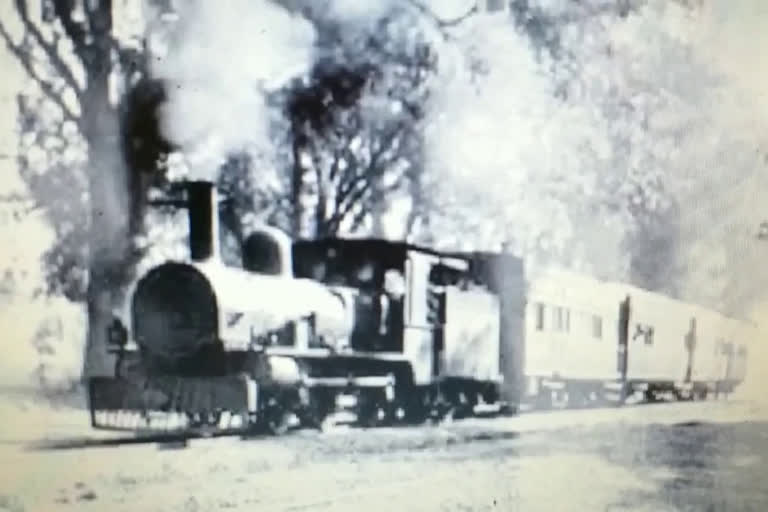Darbhanga (Bihar): Even as the government is pushing for privatisation in the Indian Railways, with the recent example being the launch of 'Tejas Express', country's first private train post Independence, India has had a glorious history so far as private trains were concerned and it goes back to the days when the country was ruled by Kings and Queens.
Tirhut Railway was one such privately-owned train service which was introduced by Maharaja Lakshmeshwar Singh of Darbhanga way back in 1874 to serve the drought-hit general public in North Bihar. It is also known as the first private train of the country.
The freight train was used to transport relief material to the drought-affected areas and ran between Vajitpur (Samastipur) to Darbhanga.
Later, it was operated as a passenger train.
Tirhut once played host to the biggest names in India's history including the likes of the first prime minister of the country Jawaharlal Nehru, the first president Rajendra Prasad, Dr. Sarvepalli Radhakrishnan, Madan Mohan Malaviya and Mahatma Gandhi, among other prominent figures.
But, the glorious past of Tirhut is long forgotten and the remnants of this pioneering train service lie in ruins since the nationalisation of Indian Railways began in 1950.
Glorious past of Tirhut
The last king of the Royal kingdom of Darbhanga Kameshwar Singh was known for his luxurious life among the British, who had honored him with the title of 'Maharajadhiraja' or the 'King of Kings'.
Around 145 years ago, king Laxmeshwar Singh had begun operating trains in Darbhanga, the lines of which ran through his fort.
In 1874, King Laxmeshwar Singh had established his company named the Tirhut Railways.
Laxmeshwar Singh contributed immensely in developing railways in Bihar. He had signed a pact with the British for establishing Tirhut Railways and also gave away a large piece of his land for construction of railway lines.
Around one thousand labourers worked hard to establish a railway line between Mokama and Darbhanga.
Tirhut Railways established several other railway lines across Bihar between 1875 and 1912.
- Dalsinghsarai to Samastipur in 1875
- Samastipur to Muzaffarpur in 1877
- Muzaffarpur to Motihari in 1883
- Motihari to Betia in 1883
- Darbhanga to Sitamarhi in 1890
- Hajipur to Bachwada in 1900
- Sakri to Jayanagar in 1905
- Narkatiaganj to Bagh in 1907
- Samastipur to Khagaria in 1912, among others.
Tirhut Railway had four steamers in 1881-82, out of which two were paddle steamers 'Eagle' and 'Fence' while two crew steamers were 'Flox' and 'Silph'.
These steamers ran between Sultanpur Ghat and Mokama-Simaria Ghat.
Darbhanga State built three railway stations in Darbhanga.
The first 'Harahi' (Darbhanga) was for the common people, the second 'Laheriasarai' was for the British and the third was 'Nargona' terminal which used to go to the Nargona Palace, the palace of the Maharaja.
Nargona Palace later fell under the ambit of Lalit Narayan Mithila University of Darbhanga.
The senator of the university Santosh Kumar said, "The royal kingdom played a crucial role in the development of railways in Bihar."
Palace on Wheels
Apart from all these public trains, Laxmeshwar Singh had also launched two royal trains named 'Palace on Wheel' which ran to-and-fro from Nargauna Terminal and Barauni until the death of the last king Kameshwar Singh's death in 1962.
It had four compartments. The first box was for the living room and bedroom, the second box for staff, the third box was for the pantry and the fourth box for the guests.
The available photographs of the salon show a carved bed in which silver is studded and 'fish' is inscribed as the symbol of Darbhanga Raj.
The forgotten legacy
Although the railway line laid by the Tirhut railway is still used today by the Indian Railways, the trains, however, which bore witness to history met a rather sad fate.
While one of the two 'Palace on Wheel' trains were looted in 1973 and set on fire, the other one was sold off as junk.
Also read: BJP leader blames Nitish Kumar for defeat in Bihar by-election



